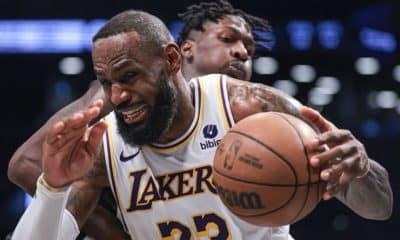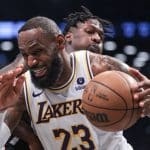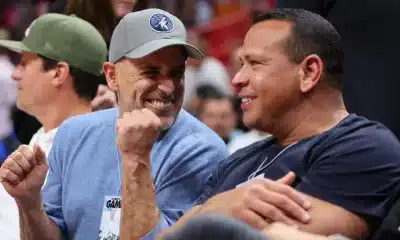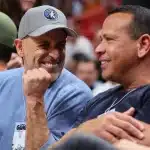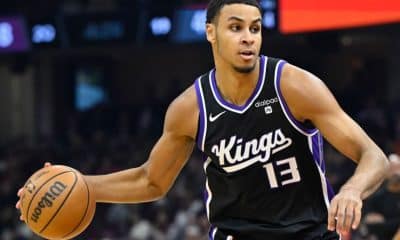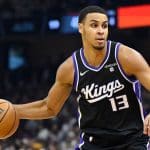NBA
Can the Bulls Bring Over Nikola Mirotic?
Nikola Mirotic is Europe’s best player. Can the Bulls negotiate his buyout and their own cap position to add him next year?

One enormous benefit of Phil Jackson’s hiring by the New York Knicks is that it has quelled the breathless speculation of Carmelo Anthony joining the Chicago Bulls this summer as a free agent. Assuming Anthony does not join the Bulls, their prime addition this summer would likely be Real Madrid power forward Nikola Mirotic. The 23-year-old Mirotic was the Spanish ACB League MVP in 2012-13 and has only improved this season. Much ink has been spilled elsewhere on his game (including my own after an in-person scouting trip last June), but it will suffice to say that his combination of shooting, skill, agility and feel are top-notch for the power forward position.
The video below provides an excellent view of the type of player he is and could become.
https://www.youtube.com/watch?v=JjaHc9Vp9wU
Mirotic would strike particular fear into the heart of opposing defenses running the pick-and-roll with Derrick Rose. His defender would have to stay relatively attached to him to prevent his popping for a three-pointer, while Rose is of course deadly on the play without a big man to deter him from getting into the lane.
Mirotic’s Buyout Complicates the Bulls’ Task
The Bulls face a number of issues bringing over Mirotic starting with his massive 2.5 million Euro buyout, which translates to $3.475 million at current exchange rates.
Buyouts from European teams are an extremely tricky business in the NBA. The Collective Bargaining Agreement prevents teams from spending more than what is known as the Excluded International Player Payment to buyout international players without it counting against the salary cap. This amount is $600,000 in 2014-15 (it has and will go up $25,000 each year of the CBA). Beyond that, any buyout amount is paid by the player. It was this buyout that prevented the Bulls from having a realistic chance to bring him over before this summer. Mirotic was the 23rd pick in the 2011 draft, and therefore was prescribed such a low salary that there is no way it would have made financial sense for him to come to the Bulls before this summer.
This summer, two things will have changed. Most importantly, the Bulls are no longer bound by the rookie wage scale, which previously would have limited Mirotic to a starting salary of a little over $1 million per year and locked him in to team control for up to four years. After three years have passed, a team has the option of signing a draftee to whatever contract it has room for via either cap room or exceptions to the cap. Such a contract must be for at least three years, exclusive of any option years.
The second new development is that the Bulls will have access to either the $5.305 million mid-level exception or cap room, which will allow them to pay Mirotic enough to entice him to come over. Here though, is where it gets even more difficult. Mirotic will have to pay the $2,875,000 remaining on his buyout after the Bulls pay the maximum $600,000 Excluded International Player Payment. Normally, this amount would count as a signing bonus.
However, paying the buyout as a signing bonus has important consequences for the size of Mirotic’s overall contract because of another rule that limits signing bonuses to 15 percent of the overall contract value. If the buyout were paid entirely as a signing bonus, that means the minimum overall value of Mirotic’s contract would be $19.2 million. On a three-year deal, this would require a first-year cap number of approximately $6.1 million, about $800,000 above the mid-level exception amount. The amount of the buyout/bonus allocable to the first (and each successive) salary cap year would be $958,333, or one third of the bonus.* If the Bulls do not amnesty Carlos Boozer to open up cap space greater than the MLE, or would simply like to pay Mirotic less, this would cause problems because they would not be able to give Mirotic a contract starting at less than $6.1 million if the entire buyout were paid as a bonus.
*For cap number purposes, the signing bonus is spread over the guaranteed years of the contract in proportion to the percentage of each contract year that is guaranteed (not the dollar amount paid in that year). Since all of the years of the contract would be fully guaranteed in this scenario, the bonus would be spread equally over the years of the contract.
This leaves two potential solutions. The first would be offering Mirotic a four-year contract. This would allow a cap number of about $4.5 million in the first year. However, Mirotic would be unlikely to take such an offer; a big part of the incentive for him to come to the NBA is to get past his first contract as soon as possible. If he is as good as it appears he will be, his second contract could be into eight figures per year.*
*One idea to make coming over more palatable, as suggested to me by Danny LeRoux, would be for Mirotic to have a fourth-year player option on his contract. This would at least allow him a larger guarantee if he is injured or underperforms. The bonus could not be spread over the fourth year because it is an option year, but it would at least make the offer slightly more appealing to Mirotic. Edit: As I wrote here (scroll down) it is not clear whether the contract could legally contain an option or not.
The second potential solution would allow the Bulls to fit Mirotic within the mid-level exception while still providing him enough cash at signing to pay his buyout. If Mirotic were to sign for the full MLE amount, his signing bonus would be limited to about $2.47 million.* This would result in a shortfall of about $397,000 to pay his buyout. However, he and the Bulls could take advantage of a provision in the CBA that allows the advance payment of salaries for a given season starting on July 1. Up to 25 percent of a player’s base compensation (i.e., not including bonuses) may be paid before October 1, and another 25 percent may be paid before regular checks start on November 15. The first 25 percent could easily cover this, as that amount would be a little over $1.1 million. Therefore, Mirotic could be given almost $3.6 million immediately upon approval of the contract, more than enough to pay the buyout.
*This is slightly less than 15 percent of the overall contract, for reasons explained by Larry Coon.
Of course, such gyrations very well might not be necessary. I am not a specialist in the Byzantine world of European basketball contracts, but it is often the case that European teams are willing to negotiate a buyout down as a reward for excellent service and/or to maintain a reputation as a good place to play. It also is not necessarily the case that all of the buyout would be due immediately, or that it could not be paid over time. But this approach would guarantee that Mirotic could meet any draconian buyout terms, if needed. In fact, that might assist in the effort to negotiate it down.
The Mirotic Negotiations Will be Fascinating
On the other hand, if the Bulls do amnesty Boozer (as appears likely), an intriguing negotiation could develop. Rare is the situation where both sides have so much leverage and yet so much incentive to get a deal done.
From Mirotic’s standpoint, he makes a reported 3.5 million Euros per year from Real Madrid, or about $4.8 million.* Contrast that with his buyout amount of $3.475 million. Considering his buyout, he will be taking a paycut over the next three years if he signs for the MLE. This would be taken out of his contract, although an international tax lawyer I consulted stated that the buyout expense should be deductible against income. Mirotic is by all accounts very happy in Spain, and plays for a dominant team. Moreover, he is really good. The Bulls desperately need the offense he would bring, and given his European performance he might merit a contract of almost eight figures right away if he were on the open market. Ryan Anderson is in the midst of a four-year, $34 million contract, and Mirotic projects to be at least his equal as a player. All of these tend to favor him getting a larger salary from the Bulls.
*Edit as of April 30, 2014: I have had multiple sources tell me that there is no way Mirotic makes anywhere near $3.5 million Euros, and in fact that they would be shocked if it is over 1 million Euros per year. That changes the calculus for him significantly.
On the other hand, the Bulls have Mirotic’s exclusive draft rights. While he is no longer bound by the rookie scale, it is not the same as if he were on the open market. Back before the rookie scale, rookies still were not paid quite as much as they would have been as veteran free agents because they can only negotiate with one team. Perhaps more importantly, Mirotic will want to get to free agency as soon as possible so that he can truly maximize his earnings over the course of his career with two big contracts that he could never hope to match in Europe. At age 23 and forced to take a minimum three-year deal to start, he needs to get to the league now. Mirotic also faces the risk that his demands will be so steep that the Bulls will decide to use their cap space on someone else, retain his rights, and go through the whole dance again next year. Mirotic is so appealing precisely because the Bulls have his exclusive draft rights and can expect to get him on a value contract. If he totally eliminates that appeal, they could go in another direction and push back the clock on his potential big payday another year.
The timing issue will also be fascinating. If the Bulls get under the cap, Mirotic will need to convince them that their cap space is worth using on him during the fast-moving free agent market. The Bulls will fear missing out on free agents and being stuck with a ton of cap space and nobody to use it on except Mirotic. That, of course, would increase his leverage. Yet by waiting, Mirotic takes the risk the Bulls will settle on someone else and be left with minimal or no cap space to offer him a deal.* This would be a bitter pill to swallow indeed and also likely lead to his remaining in Europe for another year.
*A previous version of this article stated that the Bulls could offer Mirotic their $2.7 million Room Exception for teams under the cap. However, Room Exception contracts are limited to two years. Because any Mirotic deal in excess of the Rookie Scale must be for three years, the Room Exception cannot be offered to Mirotic.
I expect a deal to get done, because both sides ultimately have the incentive to make it happen. But each also has powerful leverage on their side to push the numbers in their direction. Either way, the negotiations between Mirotic and the Bulls promise to be absolutely enthralling.
Noah and Gibson’s Incentives: The Gifts That Keep On Giving
Others have previously reported on the luxury tax ramifications incentives for Joakim Noah and Taj Gibson might have for the Bulls this season. To refresh, Noah is due a $500,000 bonus if he makes first-team All-NBA, while Gibson will earn $250,000 for making the All-Defensive Second Team and another $250,000 ($500,000 total) for making the All-Defensive First Team. While the last of these is likely out of reach for Gibson, there is a good chance these players combine to add $750,000 to their ledgers this year.
Reaching these incentives this year would also have cap ramifications for next year, assuming the players have similar incentives in 2014-15. The general rule is that incentives are included as a part of team salary if they were earned the previous year. So, any incentives earned by Noah and Gibson in 2013-14 would by default be included in the Bulls’ team salary for next season. This could lower the available cap room for the Bulls by the amount of those incentives for 2014-15, presumably $750,000 again.
Although these incentives would be included in team salary by default, there is still a procedure by which this could be challenged by the NBAPA, which theoretically has an incentive to create more cap room so that other players can get paid more. The Players’ Association can request that a basketball expert jointly selected by it and the NBA determine whether it is very unlikely that the bonus will be earned.*
*The full procedure:
1. The expert conducts a hearing within five business days, and renders a determination within five business days after that.
2. The party initiating the proceeding has the burden of proof.
3. To grant the challenge, the expert must find that player is very unlikely to earn the bonus (in the case of an NBAPA challenge) or very likely to earn bonus (in the case of an NBA challenge).
4. No party can mention whether the bonus would or wouldn’t be included under the default rule.
5. The expert’s opinion is unappealable.
6. The costs of the expert are borne equally by the parties.
In practice, however, the NBAPA has rarely challenged such designations, and seems unlikely to now when they still lack a union leader (although that will hopefully be rectified by July). Note that there is no procedure for the Bulls themselves to challenge the likely or unlikely designation of the incentives; although the team might like to do so the NBA and the NBAPA are the only parties that may initiate the procedure.
Add Basketball Insiders to your Google News Feed!
-
Main Page 1 week ago
LeBron James joins Michael Jordan as only NBA players with multiple 40-point games after turning 39
-
Main Page 1 week ago
Nikola Jokic 1st NBA player since Oscar Robertson with 26+ points, 18+ rebounds, & 16+ assists in a game
-
NBA 1 week ago
Ex-MLB star Alex Rodriguez vows to keep trying to buy Timberwolves franchise despite rejection
-
Main Page 1 week ago
Kings are 14-5 this season when Keegan Murray scores 19+ points
